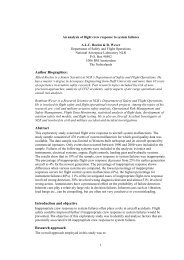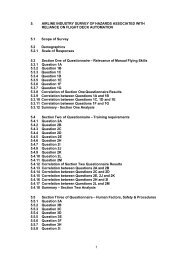Causal risk models of air transport - NLR-ATSI
Causal risk models of air transport - NLR-ATSI
Causal risk models of air transport - NLR-ATSI
You also want an ePaper? Increase the reach of your titles
YUMPU automatically turns print PDFs into web optimized ePapers that Google loves.
that, while a causal <strong>risk</strong> model can be used in a TLS approach, the model can fully come to<br />
justice in an ALARP approach which strives for continuous improvement.<br />
2.5. Theories about accident causation<br />
Risk from <strong>air</strong> <strong>transport</strong> is almost exclusively related to accidents 9 . In a desire to understand<br />
and prevent the occurrence <strong>of</strong> accidents, many researchers have tried to develop a concept<br />
or framework for describing accident causation. Some <strong>of</strong> these theories have been very<br />
influential on the way we think about accidents and the representation <strong>of</strong> accidents in<br />
mathematical <strong>models</strong>. For that reason this section provides a brief overview <strong>of</strong> some <strong>of</strong> the<br />
most important accident causation theories and concludes with what this means for <strong>risk</strong><br />
model requirements.<br />
For the purpose <strong>of</strong> accident investigation, it is <strong>of</strong>ten assumed that accidents involve the<br />
occurrence <strong>of</strong> a set <strong>of</strong> successive events that produce unintentional harm. The start <strong>of</strong> this<br />
sequence is a deviation or perturbation that disturbs the existing equilibrium or state <strong>of</strong><br />
homeostasis. Benner [1975] pointed out that events during accidents occur both in series<br />
and in parallel and proposed flow charting methods to represent this. Accident investigation<br />
tools like Event and <strong>Causal</strong> Factors Analysis (ECFA) [Buys & Clark 1995] and<br />
Management Oversight and Risk Tree (MORT) [Johnson 1975] use this concept to provide<br />
a structure for integrating and subsequently communicating investigation findings. Already<br />
in 1935, Heinrich developed a theory that introduces an additional dimension to such<br />
accident chain model. He compared the occurrence <strong>of</strong> an accident to a set <strong>of</strong> lined-up<br />
dominoes [Heinrich et al 1980]. The five dominoes were a) ancestry and social<br />
environment, b) worker fault, c) unsafe act or unsafe condition, d) accident and e) damage<br />
or injury. Central to Heinrich’s original statement <strong>of</strong> the model is the assertion that the<br />
immediate causes <strong>of</strong> accidents are <strong>of</strong> two different types; unsafe acts and unsafe conditions.<br />
Heinrich’s domino model was also useful to explain how by removing one <strong>of</strong> the<br />
intermediate dominoes, the remaining ones would not fall and the injury would not occur.<br />
Reason [1990] took Heinrich’s unsafe acts and unsafe conditions a step further by refining<br />
the distinction between different types <strong>of</strong> failures that line up to create an accident. Building<br />
upon work by Rasmussen [1983], Reason describes an accident as a situation in which<br />
latent failures, arising mainly in the managerial and organisational spheres, combine<br />
adversely with local trigger events (weather, location etc) and with active failures <strong>of</strong><br />
individuals at the operational level. Latent failures are failures that are created a long time<br />
before the accident, but lie dormant until an active failure triggers their operation. Their<br />
defining feature is that they were present within the system well before the onset <strong>of</strong> an<br />
accident sequence. Like many other high-hazard, low-<strong>risk</strong> systems, the aviation system has<br />
developed such a high degree <strong>of</strong> technical and procedural protection that it is largely pro<strong>of</strong><br />
against single failures, either human or mechanical. The aviation system is more likely to<br />
suffer ‘organizational accidents’ [Reason 1990]. That is, a situation in which latent failures,<br />
arising mainly at the managerial and organizational level, combine adversely with local<br />
triggering events and with the active failures <strong>of</strong> individuals at the execution level [Reason<br />
1997]. This concept is <strong>of</strong>ten graphically illustrated as slices <strong>of</strong> holed cheese, each slice<br />
representing a barrier at a different organisational level. The holes in the cheese are barrier<br />
failures and an accident occurs when the holes line up. The ‘Swiss cheese’ model has been<br />
useful to underline the importance <strong>of</strong> organisational factors in accidents. Perrow [1984] also<br />
describes accidents as occurrences where apparently trivial events cascade through the<br />
system to cause a large event with severe consequences. He uses the term ‘normal<br />
9<br />
Examples <strong>of</strong> non-accident <strong>risk</strong> in <strong>air</strong> <strong>transport</strong> are deep vein thrombosis and possible<br />
health effects <strong>of</strong> exposure to higher levels <strong>of</strong> electromagnetic radiation.<br />
19




